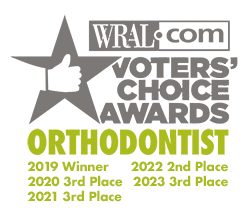Key Points
-
- The two most common teeth-aligning treatments are metal braces and Invisalign.
- Metal braces are attached to your teeth for the duration of the treatment. A wire is threaded through the slots on the bracket to guide the teeth into their ideal positions.
- Ceramic braces function like metal braces but are tooth-colored and less noticeable. However, they tend to break more easily.
- Lingual braces are affixed to the inside surface of your teeth instead of the outside, and can be cumbersome and irritating to the tongue. This type of treatment is less common and isn’t suitable for every patient.
- Invisalign is a series of clear, custom-fitted, removable plastic aligners that fit over a patient’s teeth like a thin, close-fitting mouth guard.
- Treatment times for all types of braces are similar. For typical orthodontic patients, the average treatment time is about 18-24 months. Minor treatment and orthodontic “touch-ups” may last only 6-12 months. The treatment time varies depending on each patient’s unique needs.
Straightening your teeth has never been easier. While metal braces are still a frequently used method for straightening teeth, there are many alternative options available, such as clear aligners like Invisalign, ceramic braces, and lingual braces. Everyone’s teeth and jaw structures are different, so the best way to determine which type of braces are best for you is to consult with an experienced orthodontist. They can help you determine which type of braces is best for creating your new healthy smile.
Types of Braces
The two most common teeth-aligning treatments are metal braces and Invisalign. These two options’ treatment time and cost are relatively similar in most cases. Most of the time, the choice between Invisalign and metal braces comes down to personal preference and lifestyle. However, traditional metal braces may be the only option in some more complicated straightening cases.
Metal Braces
Metal braces are attached to your teeth for the duration of your treatment. The wire that is threaded through the slots on the brackets provides the force needed to move the teeth and guides the teeth into their correct positions. Metal braces are made from surgical-grade stainless steel and are smaller and much more comfortable than they used to be. There are lots of color options for tiny o-rings that hold the wire to the brackets, so you can show off your style while creating your dream smile. With metal braces, you need to visit your orthodontist every 4-6 weeks for adjustments to guide your teeth.
Ceramic Braces
Ceramic braces function essentially the same way as metal braces. Like metal braces, the brackets are secured to your teeth for the duration of orthodontic treatment. The primary difference is the ceramic or tooth-colored material of the brackets, making them less noticeable than metal. Despite this benefit, ceramic braces do have a drawback. Ceramic brackets tend to be larger and more brittle than their metal counterpart, posing a greater risk of broken brackets. Sometimes orthodontists will use ceramic brackets just on the top front teeth to mitigate that risk.
Lingual Braces
Lingual braces are very similar to metal and ceramic braces. However, instead of the brackets and wires facing outward on the front of your teeth, lingual braces are affixed to the inside surface of your teeth, adjacent to your tongue. This type of treatment is less common and isn’t suitable for every patient. If you’re interested in this option, ask your orthodontist if you are a good candidate for lingual braces.
Clear Aligners or Invisalign
Invisalign is a series of clear, custom-fitted, removable plastic aligners that fit over a patient’s teeth like a thin, close-fitting mouth guard. These aligners are engineered to move a patient’s teeth incrementally to their desired positions over time. Some patients call these aligners “invisible braces,” and they generally follow these guidelines:
-
- Each aligner is typically worn for one week, then replaced by the next aligner in the series
- If an aligner is lost or broken, the patient simply moves to the next aligner
- Daily wear time is 20 hours per day
- The total number of aligners in the series depends on your orthodontic needs
- Most patients will need temporary tooth-colored bumps or “attachments” placed on their teeth that help the aligners move the teeth properly
- Appointments with your orthodontist are typically scheduled much farther apart than with metal, ceramic or lingual braces, oftentimes at three month intervals.
What Type of Braces Work the Fastest
Treatment times for metal, ceramic and lingual braces have about the same total treatment time as Invisalign. In most cases, patients will complete orthodontic treatment in about 12-18 months. However, this will depend on how well patients keep up with routine orthodontic checkups and changing aligners as directed.
Best Types of Braces for Adults
Adults have the most options for teeth-straightening as they are more often motivated to keep up with their orthodontic responsibilities. For example, a middle school student might easily toss away an Invisalign aligner at lunchtime. In contrast, an adult is more likely to remember to put it back in their mouth after eating. Most adults can select any teeth-straightening treatment they like if their orthodontist deems them viable candidates.
Choosing the Right Braces for Your Smile
It is essential to schedule a consultation with an experienced orthodontist to be sure you have all the information you need to make an informed decision about your orthodontic journey. Regardless of your teeth straightening choice, know that under the care of an experienced orthodontist, your treatment will result in a beautiful, healthy smile if you follow your orthodontist’s protocol.
Aesthetics
Choosing which type of braces to straighten your teeth is an aesthetic decision for many. Regardless of which method you choose, you’ll be able to show off a beautifully straightened smile at the end of your orthodontic treatment. But what about during treatment? If you’re concerned about the appearance of your teeth during your orthodontic treatment, Invisalign is probably your best bet. Invisalign is, as the name suggests, virtually invisible.
Diet: What foods should be avoided with the different types of braces?
With metal or ceramic braces, you’ll have to avoid hard and sticky foods that may dislodge the braces or bend the archwires. You won’t be able to bite into apples and you’ll have to cut harder foods into small bites. Sugar free gum is usually ok, but other sugary food should be avoided to reduce the risk of cavities developing around the braces. However, with clear aligners, you will remove the aligners every time you eat, so there are no dietary restrictions during your orthodontic treatment.
Oral Hygiene: Keeping your teeth clean during your orthodontic treatment
Clear aligners are removed for normal brushing and flossing. It’s very important to clean your teeth before putting your aligners back on to reduce the risk of developing cavities under the aligners and to never drink sugary or acidic drinks with the aligners in place. With metal, ceramic or lingual braces, you’ll be given small brushes and floss-threaders to help clean around the braces and protect your teeth during your orthodontic treatment.
Budget
Having a healthy, beautiful smile is desirable, as is staying on budget. At first glance, you might assume that Invisalign is a lot more expensive than metal or ceramic braces. But, for most patients, the cost of Invisalign is quite similar. The cost can range from $3,000 to $8,000 for Invisalign. The same is true for metal or ceramic braces, depending on the patient’s needs.
Contact Walton & Maready Orthodontics for a free consultation in Raleigh, North Carolina, today if you’re ready to explore your orthodontic treatment options. Get the smile of your dreams with experienced, professionally trained orthodontists. Your teeth and your healthy smile will thank you!




